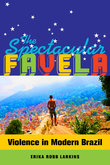The Spectacular Favela: Violence in Modern Brazil

After reading The Spectacular Favela by Erika Robb Larkins, you will feel that you have lived in Rocinha, the Rio de Janeiro favela where Larkins herself lived for a total of 31 months between 2008 and 2014. Here, in this most (in)famous favela of Latin America, Larkins explores violence and seeks to understand how its commodification and spectacle are central to its production.
This book comprises five chapters and is based upon Larkins’s ethnographic research on violence in Rocinha. This is informed by 85 formal interviews and over 250 informal interviews, plus Larkins’ experience assisting a local NGO, accompanying hundreds of favela tours, working as a hostel receptionist, and – most significantly – residing within the favela for extended periods of time and building relationships with its inhabitants.
Chapter 1 puts forth what Larkins calls the “trafficker state”. In other words, she describes how traffickers consolidate their power within the favela through daily forms of trafficker governance, in particular spectacles of violence and wealth. She also identifies their two principal legitimating discourses: employing validating paradigms of state government, and seeing themselves as a successful corporation within a competitive marketplace (page 38).
In Chapter 2, Larkins explores the penal state and illustrates how the police (as its representatives) both “embody violent spectacle and contribute to the commodification of security” or insecurity (page 57). Furthermore, she shows how corrupt members of the penal state thrive economically through their connection with favela criminality, as well as enabling the ongoing power of traffickers and thus perpetuating violence against the poor (page 79).
“Favela, Inc” is the title of Chapter 3. This coinage by Larkins pertains to the commodification of the favela as a marketable global brand. In this chapter she considers how the favela is consumed in disembodied fashion, through media, and how this does little to correctly portray real-life complexities nor offer any significant relief to the poor.
Following on from the concept of “Favela, Inc.”, in Chapter 4 Larkins examines how the favela is consumed in embodied fashion through tourism. Through this she argues that tourists become part of producing favela violence and are guilty of its reproduction.
The final chapter explores the pacification of Rocinha by drawing upon Larkin’s research in the pre-pacified favela, and then immediately and 15 months after pacification. Larkins considers how systems of security shift from the traffickers to the state; the contradiction of pacifying “the favela as a place that requires violence to achieve peace” (page 141); and finally how the promotion of security through pacification has ironically created insecurity (page 156).
Larkin concludes her book with an epilogue drawing out key conclusions and highlighting the larger socio-political relationships that favela conflict is embedded in (page 164). Larkins also critically evaluates her role as ethnographer.
This academic book reads almost like a novel – gripping its reader’s attention with a rich array of characters, experiences, and conversations – as it tells the story of Rocinha favela. Yet it is a far cry from a novel. Indeed, the lives it portrays and theoretical dialogue it creates on violence, its spectacle and commodification are of critical importance to further understanding violence in the margins of society, like the favelas of Rio.
Book note prepared by Hannah Keren Lee
Search the Book notes database
Our Book notes database contains details and summaries of all the publications included in Book notes since 1993 - with details on how to obtain/download.
Use the search form above, or visit the Book notes landing page for more options and latest content.
For a searchable database for papers in Environment and Urbanization, go to http://eau.sagepub.com/

